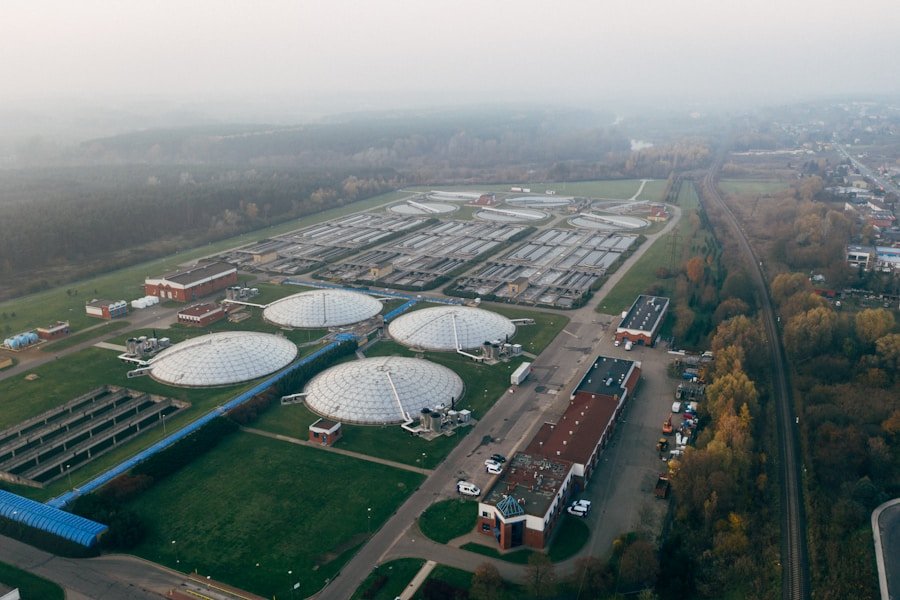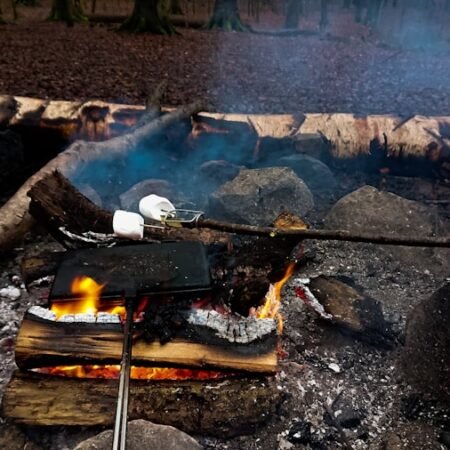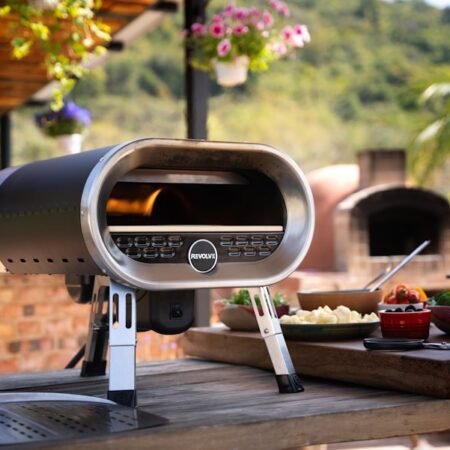When engaging in camping activities, fire safety must be a top priority. The risk of a fire breaking out is ever-present, whether you’re cooking over an open flame, utilizing a portable stove, or gathering around a campfire. It is essential to comprehend the potential dangers and take necessary precautions to ensure a safe and enjoyable camping experience for all participants.
A crucial aspect of fire safety while camping is being prepared for unforeseen circumstances. This involves possessing the necessary tools and knowledge to effectively handle a fire emergency should one occur. Additionally, it is vital to be aware of your surroundings and identify potential fire hazards within the campsite.
By recognizing the importance of fire safety and taking proactive measures, you can significantly minimize the risk of a fire disrupting your camping trip.
Key Takeaways
- Understanding the importance of fire safety while camping is crucial for a safe and enjoyable trip.
- Choosing the right type of fire extinguisher for your camping trip can make a significant difference in emergency situations.
- Properly maintaining and storing fire extinguishers for outdoor use is essential for their effectiveness.
- Training and educating your camping group on fire extinguisher usage can save lives in case of a fire emergency.
- Identifying and addressing common fire hazards in a campsite is key to preventing fires and ensuring a safe camping experience.
Choosing the Right Type of Fire Extinguisher for Your Camping Trip
When it comes to fire safety while camping, having the right type of fire extinguisher can make all the difference. There are several different types of fire extinguishers available, each designed to handle specific types of fires. For camping trips, it’s important to choose a fire extinguisher that is suitable for use on Class A, B, and C fires, as these are the most common types of fires that can occur in a campsite.
A multipurpose dry chemical fire extinguisher is often the best choice for camping trips, as it can effectively extinguish fires caused by wood, paper, flammable liquids, and electrical equipment. These types of fire extinguishers are also relatively lightweight and easy to transport, making them ideal for outdoor use. When selecting a fire extinguisher for your camping trip, be sure to check the label for the appropriate class ratings and ensure that it is fully charged and in good working condition.
Properly Maintaining and Storing Fire Extinguishers for Outdoor Use
Proper maintenance and storage of fire extinguishers are essential for ensuring their effectiveness in the event of a fire emergency. Before heading out on your camping trip, it’s important to inspect your fire extinguisher to ensure that it is in good working condition. This includes checking the pressure gauge, inspecting the hose and nozzle for any damage, and ensuring that the pin and tamper seal are intact.
When storing your fire extinguisher for outdoor use, it’s important to keep it in a location that is easily accessible in case of an emergency. This may mean keeping it in a designated storage compartment in your vehicle or near your campsite. It’s also important to protect your fire extinguisher from extreme temperatures and harsh weather conditions, as these can affect its performance.
By properly maintaining and storing your fire extinguisher, you can ensure that it is ready for use when you need it most.
Training and Educating Your Camping Group on Fire Extinguisher Usage
| Fire Extinguisher Type | Class of Fire | Effective Against | Size/Weight |
|---|---|---|---|
| Water and Foam | A | Wood, paper, cloth, and some plastics | 2.5 gallons / 9-10 lbs |
| Carbon Dioxide (CO2) | B, C | Liquid and electrical fires | 5-20 lbs |
| Dry Chemical | A, B, C | Flammable liquids, electrical fires, and combustible metals | 2.5-20 lbs |
| Wet Chemical | K | Cooking oil and grease fires | 2.5 gallons / 9-10 lbs |
In addition to having the right tools, it’s important to ensure that everyone in your camping group is trained and educated on how to use a fire extinguisher effectively. This includes understanding the different types of fires and how to identify them, as well as knowing how to operate a fire extinguisher safely and efficiently. Taking the time to educate your camping group on fire extinguisher usage can make all the difference in the event of a fire emergency.
One way to train and educate your camping group on fire extinguisher usage is to hold a demonstration before heading out on your trip. This can involve showing everyone how to operate a fire extinguisher and practicing using it in a controlled setting. It’s also important to discuss the different types of fires that can occur in a campsite and how to identify them, as well as the appropriate steps to take in the event of a fire emergency.
By training and educating your camping group on fire extinguisher usage, you can ensure that everyone is prepared to handle a fire emergency should one arise.
Identifying and Addressing Common Fire Hazards in a Campsite
Another important aspect of fire safety while camping is identifying and addressing common fire hazards in a campsite. This can include things like overhanging branches near a campfire, flammable materials near cooking areas, or improperly stored fuel for portable stoves. By being aware of these potential hazards, you can take proactive measures to minimize the risk of a fire breaking out.
One way to identify and address common fire hazards in a campsite is to conduct a thorough inspection of the area before setting up camp. This can involve looking for potential fuel sources for fires, ensuring that cooking areas are clear of flammable materials, and making sure that campfires are located in safe areas away from overhanging branches or dry vegetation. It’s also important to communicate with your camping group about potential fire hazards and establish clear guidelines for fire safety while at the campsite.
Emergency Response Protocols for Dealing with Campsite Fires
Despite taking all necessary precautions, there is always a chance that a fire emergency could occur while camping. In the event of a campsite fire, it’s crucial to have established emergency response protocols in place to ensure everyone’s safety. This can include having designated meeting points, assigning specific roles and responsibilities to members of the camping group, and knowing how to contact emergency services if needed.
One important aspect of emergency response protocols for dealing with campsite fires is having an evacuation plan in place. This involves identifying multiple escape routes from the campsite and ensuring that everyone knows where to go in the event of a fire emergency. It’s also important to establish clear communication channels within the camping group so that everyone can be accounted for in the event of an evacuation.
By having established emergency response protocols for dealing with campsite fires, you can minimize the risk of injury or loss in the event of a fire emergency.
Additional Fire Safety Tips for a Safe and Enjoyable Camping Experience
In addition to having the right tools and knowledge for handling a fire emergency, there are several additional fire safety tips that can help ensure a safe and enjoyable camping experience. One important tip is to always keep a close eye on any open flames or cooking equipment while at the campsite. This means never leaving a campfire unattended and ensuring that portable stoves are used in a safe and responsible manner.
Another important fire safety tip for camping is to be mindful of local regulations and restrictions regarding open fires. Some campsites may have specific rules about where and when fires can be lit, so it’s important to familiarize yourself with these regulations before setting up camp. It’s also important to have a plan for properly extinguishing any open flames before leaving the campsite or going to bed for the night.
In conclusion, fire safety is an essential aspect of any camping trip. By understanding the importance of fire safety, choosing the right type of fire extinguisher, properly maintaining and storing fire extinguishers, training and educating your camping group on fire extinguisher usage, identifying and addressing common fire hazards in a campsite, establishing emergency response protocols for dealing with campsite fires, and following additional fire safety tips, you can ensure a safe and enjoyable camping experience for everyone involved. With the right tools, knowledge, and proactive measures in place, you can minimize the risk of a fire ruining your camping trip and enjoy all that nature has to offer with peace of mind.
FAQs
What are the different types of fire extinguishers?
There are five main types of fire extinguishers: Class A, Class B, Class C, Class D, and Class K. Each type is designed to extinguish different types of fires, such as those involving wood or paper, flammable liquids, electrical equipment, combustible metals, and cooking oils or fats.
How do fire extinguishers work?
Fire extinguishers work by removing one or more of the elements that a fire needs to burn. This can include removing oxygen, cooling the fire, or interrupting the chemical reaction that allows the fire to continue burning.
How do I choose the right fire extinguisher for camping?
When choosing a fire extinguisher for camping, it’s important to consider the types of fires that are most likely to occur. A multi-purpose fire extinguisher that is effective on Class A, B, and C fires is a good choice for camping, as it can handle a variety of common camping fire hazards.
How do I use a fire extinguisher?
To use a fire extinguisher, remember the acronym “PASS”: Pull the pin, Aim the nozzle at the base of the fire, Squeeze the handle to release the extinguishing agent, and Sweep the nozzle from side to side until the fire is out.
How often should fire extinguishers be inspected and maintained?
Fire extinguishers should be inspected and maintained at least once a year by a qualified professional. They should also be visually inspected monthly to ensure that they are in good working condition.












